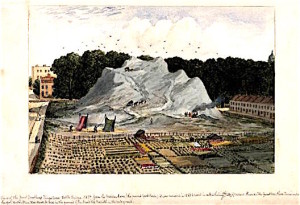 A central character in Dickens’ Our Mutual Friend (1865) is Nicodemus Boffin, nicknamed ‘The Golden Dustman ‘ because of the wealth he inherited from his old employer John Harmon, who had made his fortune as a Dust Contractor at Somers Town. These famous rubbish piles stood where the filthy Maiden’s Lane (now roughly York Way) joined onto Pentonville Road, near where Kings Cross station now stands. Here, just about anything could be found—‘dust ‘ was a Victorian euphemism; there was more likely to be dead dogs ,cats, horses, discarded pots and pans, crockery, shoes, boots, old clothes and all sorts of debris from the surface of roads, including grit, horse dung, dog dirt, as well as the human excrement collected by the scavengers. All this so called ‘dust’, once separated, could be sold to various factory owners for large profits. Dickens, who loved exploring London, once lived in Doughty Street, which is just a mile from the famous Somers Town dust heaps, and must have known them well. He also became friendly with a wealthy Dust Contractor from Islington called Henry Dodd who, at his death in 1881, left a fortune of £111,000. It has been argued that the character of Boffin was based on Dodd.
A central character in Dickens’ Our Mutual Friend (1865) is Nicodemus Boffin, nicknamed ‘The Golden Dustman ‘ because of the wealth he inherited from his old employer John Harmon, who had made his fortune as a Dust Contractor at Somers Town. These famous rubbish piles stood where the filthy Maiden’s Lane (now roughly York Way) joined onto Pentonville Road, near where Kings Cross station now stands. Here, just about anything could be found—‘dust ‘ was a Victorian euphemism; there was more likely to be dead dogs ,cats, horses, discarded pots and pans, crockery, shoes, boots, old clothes and all sorts of debris from the surface of roads, including grit, horse dung, dog dirt, as well as the human excrement collected by the scavengers. All this so called ‘dust’, once separated, could be sold to various factory owners for large profits. Dickens, who loved exploring London, once lived in Doughty Street, which is just a mile from the famous Somers Town dust heaps, and must have known them well. He also became friendly with a wealthy Dust Contractor from Islington called Henry Dodd who, at his death in 1881, left a fortune of £111,000. It has been argued that the character of Boffin was based on Dodd.
A contemporary sketch of the Somers Town site is dated 1836, but doubtless contractors had been adding to the muck heaps for many years up this date. Scavengers are depicted clambering over the filthy heaps in search of the more valuable items to sell on, a process that still takes place in some third world countries. It is interesting to find, therefore, a London Times classified advertisement of December 6th 1820, when Dickens was a boy of eight, requesting Dust Contractors to tender for a contract in Chelsea.
